The Czech Republic has been a frequent participant in the European Championship, having appeared as part of Czechoslovakia until 1992, and they have qualified for every edition of the tournament since then as well. The Czechs are part of Group D at Euro 2020, along with England, Croatia and Scotland, for which they qualified by finishing second in their qualification group, incidentally behind England. The Czech Republic finished as runners-up at Euro 1996, which is their best performance at the European Championships, but went out at the group stage at Euro 2016, and given the strength of their group, it may be a tricky task for them to qualify for the knockout stages.
In this scout report, we will make an analysis of Czech Republic tactics and performance through data. It contains tactical analysis on frequent patterns in the attacking phase, defensive phase and transition.
THE SQUAD
Goalkeepers:
Vaclík Tomáš
Pavlenka Jiří
Mandous Aleš
Defenders:
Coufal Vladimír
Kadeřábek Pavel
Čelůstka Ondřej
Kalas Tomáš
Zima David
Bořil Jan
Matějů Aleš
Brabec Jakub
Midfielders:
Masopust Lukáš
Darida Vladimír (c)
Souček Tomáš
Barák Antonín
Král Alex
Holeš Tomáš
Ševčík Petr
Jankto Jakub
Hložek Adam
Pešek Jakub
Forwards:
Schick Patrik
Krmenčík Michael
Vydra Matěj
Pekhart Tomáš
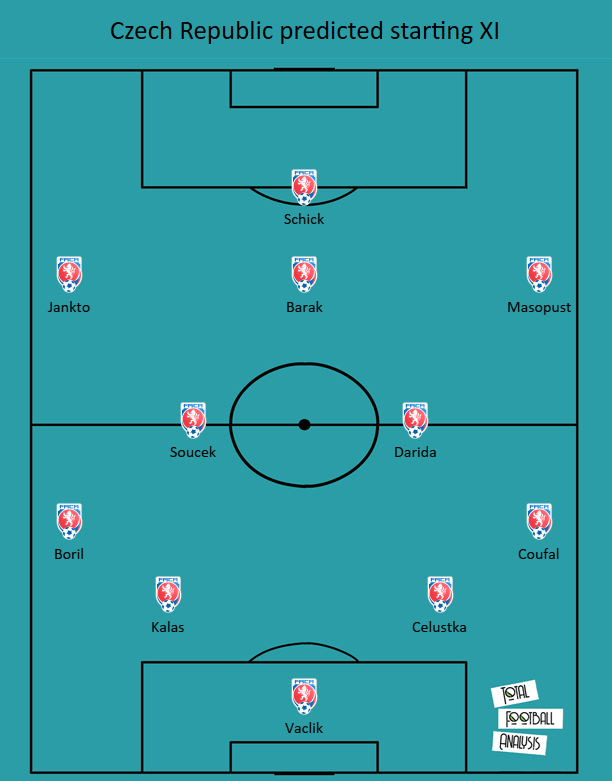
Czech Republic has a solid starting XI with some very good players playing in the top leagues. Sevilla goalkeeper Tomas Vaclík should be the starting goalkeeper but he has not played regularly for Sevilla this season, which makes us lean towards Werder Bremen’s Jiří Pavlenka as the man between the sticks for the Czechs at Euro 2020.
Sparta Prague’s Ondřej Čelůstka and Bristol City’s Tomáš Kalas will start as the centre-back pair, with Slavia Prague’s Jan Bořil as the left-back. The West Ham right-back Vladimir Coufal will be one of the key players for this side, and he will look to carry forward his superb club form for his country, having joined the Hammers from Slavia Prague in the summer.
Another Czech player that joined West Ham this summer from Slavia Prague is Tomáš Souček. Souček is the star of this team and their results in this tournament will depend a lot on his performances. Alongside Souček in midfield, we can expect to see Vladimir Darida of Hertha Berlin, and Udinese’s attacking midfielder Antonín Barák who will have a little more offensive freedom in front of Souček and Darida. Alex Král is a player worth mentioning and he could easily start instead of Barák which would mean that Král would take the holding midfielder role, with Souček pushed further forward.
Jakub Jankto is a player that can make difference for the Czech Republic in this tournament, with the Sampdoria winger playing on the left. Lukáš Provod, who would have been expected to start on the right, injured his knee and he won’t be able to play in this tournament while his potential replacement Václav Černý also suffered a knee injury and probably won’t recover till the start of the tournament either. That opens up a spot for either Lukáš Masopust or some other players who are not natural wingers, such as Adam Hložek or the experienced Matěj Vydra. We expect Bayer Leverkusen’s Patrick Schick to be the starting centre-forward with Michael Krmenčík offering backup and both of them fit Czech Republic tactics with the target man upfront.
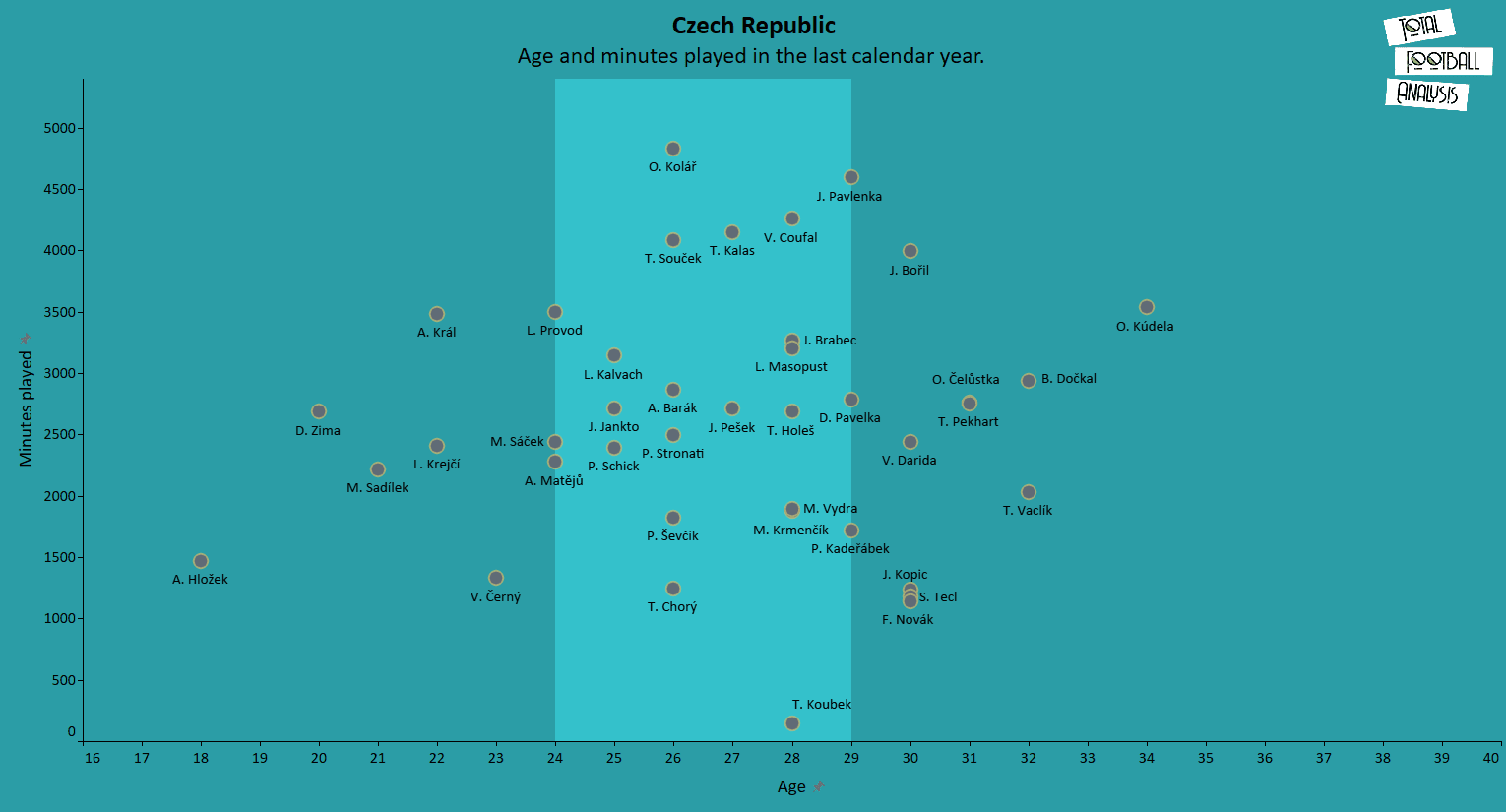
On this graph, we can see the 40 players who have been called up for the Czech side over the last calendar year. We can see that most of their peak players have had high playing time in the last calendar year which is a good sign and should mean that they arrive in good condition for Euro 2020. The team has a good mix between youth and experience, and we can expect some of the younger players to feature throughout the Czech Republic’s journey at this tournament.
ATTACKING PHASE
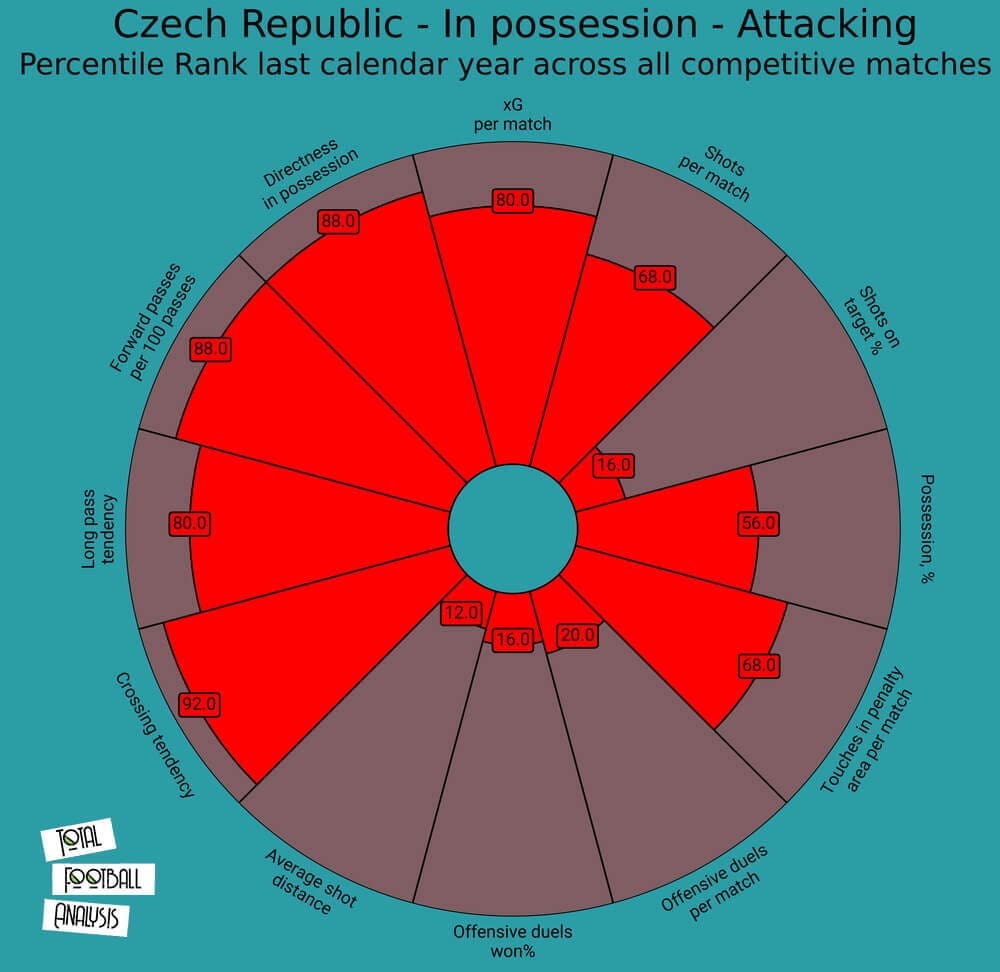
Looking at the Czech Republic attacking chart, we can immediately see that they are very direct – they tend to play a lot of long passes and they try to deliver the ball into the box whenever they have a chance. The percentiles confirm that their style of play is very efficient based on xG per match and shots per match and they manage to create quality chances through their direct style.
The Czech Republic is not focused a lot on positional football and they feel most comfortable in transitions. They are in the 80th percentile for long passes and in the 88th percentile when it comes to directness in possession. They rely on their target-man like Patrick Schick and Michael Krmenčík who are tall and strong forwards able to hold up the ball and win aerial duels in an attempt to move the ball into open spaces for their wingers. Their tendency for direct play is also seen through the high rank for crossing tendency (92nd percentile), which indicates their preference for getting the ball wide and sending in crosses for their strikers and attackers to contest in the box.
Their xG (expected goals) and shooting numbers look very good compared to the other teams in the tournament. They manage to get their attacks to count with very high xG (80th percentile) even though they are not amongst the top teams when it comes to shooting attempts (68th percentile). However, their high xG can be connected with the distance of shots because their average shooting distance is around 15.8 metres away from the goal, only France and Russia are shooting from a closer distance on average. If we look at the main problem with their shooting metrics it is their shooting accuracy. They sit at the 16th percentile in shots on target % which is surely something that they need to improve on at this stage.
They are not involved in many offensive duels and they are amongst those teams who are below average when it comes to offensive duels winning rate. It is still not something concerning because they are winning 40.2% of their offensive duels while the best team in that department, Wales wins 45.7% which isn’t such a big difference.
We can see that the Czech Republic is above average when it comes to possession and they are averaging 53.7% ball possession per match even though they tend to play direct and fast football with a lot of transition, however, when they played against weaker opponents they held onto possession more patiently. They manage to get a lot of touches in the penalty area as well which is a good sign of their creativity.
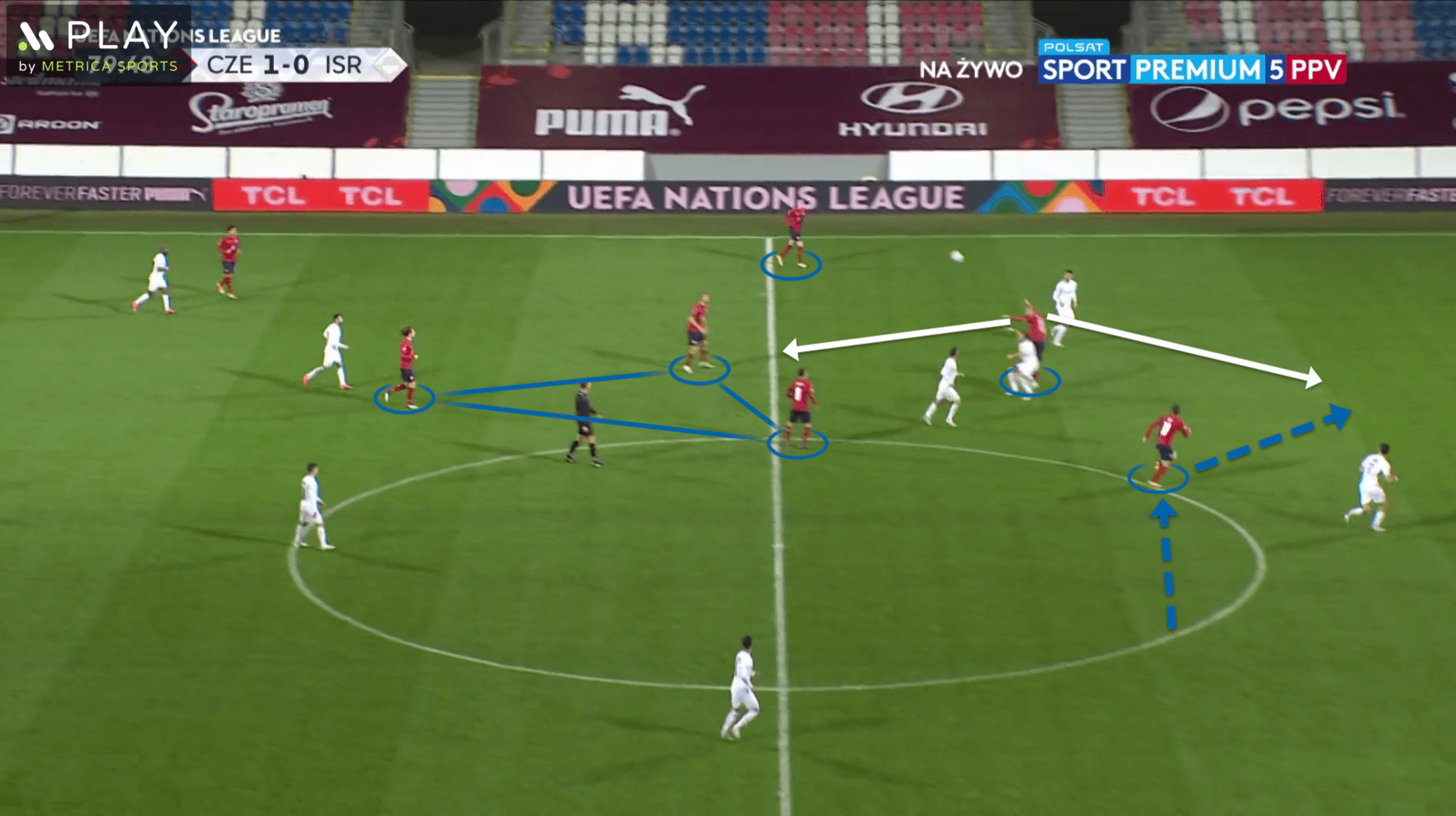
This is something we can see from the Czech Republic on a regular basis, whether it is to start a counter-attack or when the opponent is defending in structure. Their goalkeeper and centre-backs look to find centre-forward with a long pass on the opponent half.
What they look to do from these situations is that their target man proceeds the ball into the space behind him where wingers are making their runs. Both Jankto and Provod did that part well, however, it will be interesting to see who will replace Provod on the right-wing. It won’t be a surprise if we see Schick on the right-wing while Krmenčík starts in the central role. In that situation, they would have two options for long passes leaving their opponents in doubt where to pay more attention.
Of course, if their target man doesn’t win the aerial duel or hold the ball, their midfielders are very close and prepared to pick up deflected balls. We can see in a situation that their three midfielders created a triangle and it is hard for the ball to go past them if deflected. Their midfielders cover a lot of ground and try to be involved in these situations where they pick up the ball and pass it wide while continuing their run towards the opponent’s goal. We know that Soucek is one of the best midfielders right now in the football world in that kind of actions, he is capable of arriving in the penalty area off the ball and get into the right spots to score.
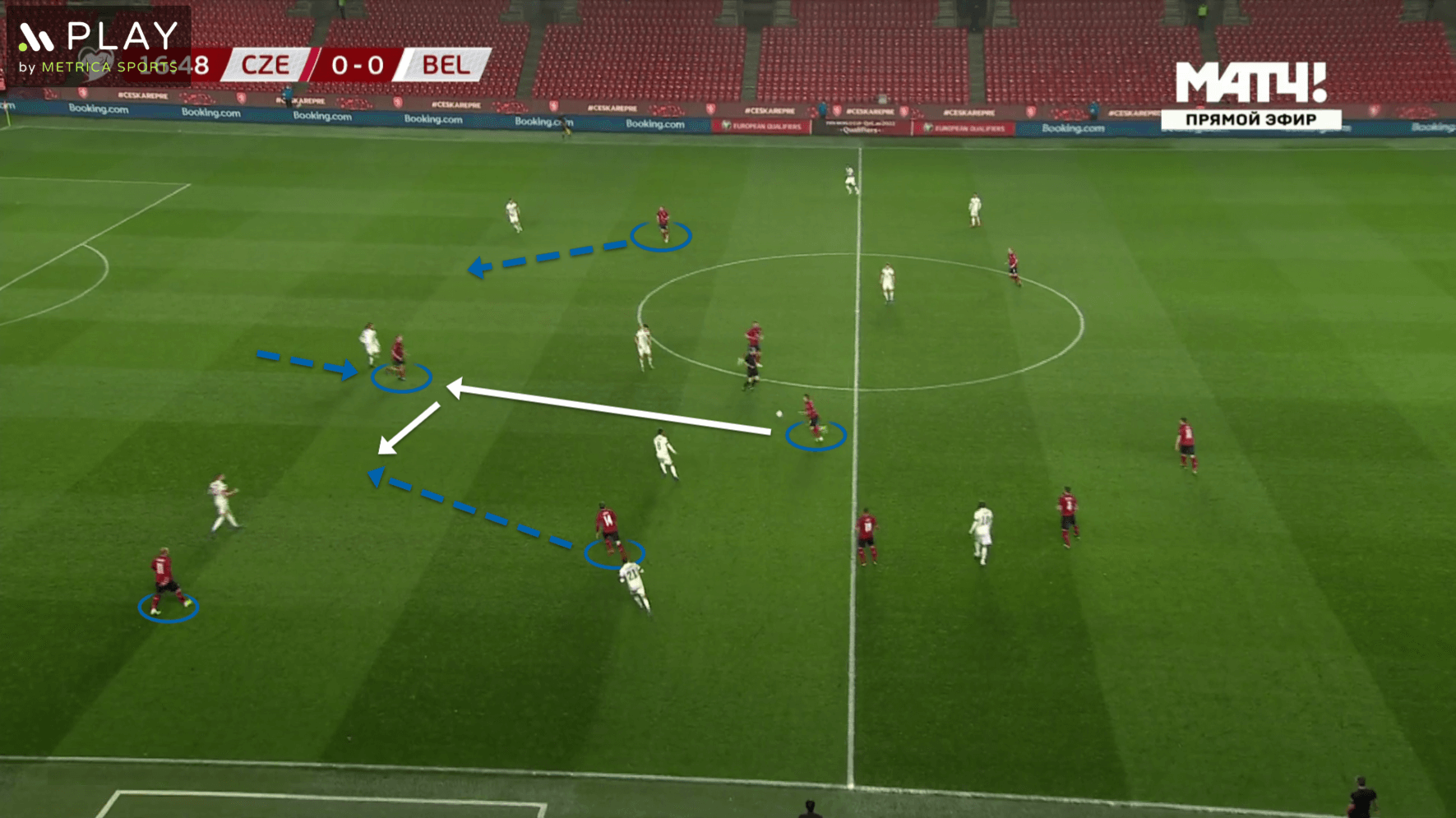
In this example, we can see how they try to attack through ground passes which are very similar to the previous example. Their centre-forward drops deeper to receive the ball from the midfielder and draws attention from the centre-back who follows him opening the space behind. Again that space is mostly attacked by the opposite winger while the closer winger keeps the closest defender wide. Because a closer winger keeps the defender wider it opens the space for the midfielder to make a run and offer himself as an option for a pass from centre-forward.
Darida is often the distributor in these situations while Souček and Barák along with Jankto who likes to position himself in half-space are the players who look to receive the ball from centre-forward. Both Schick and Krmenčík have the ability to hold the ball and make accurate passes for supporting midfielders. They are capable of keeping possession a little bit longer but they try to be more direct and look for situations like this to create chances with few quick passes especially when they play against better opponents like England and Croatia who they face in the group stage.
DEFENSIVE PHASE
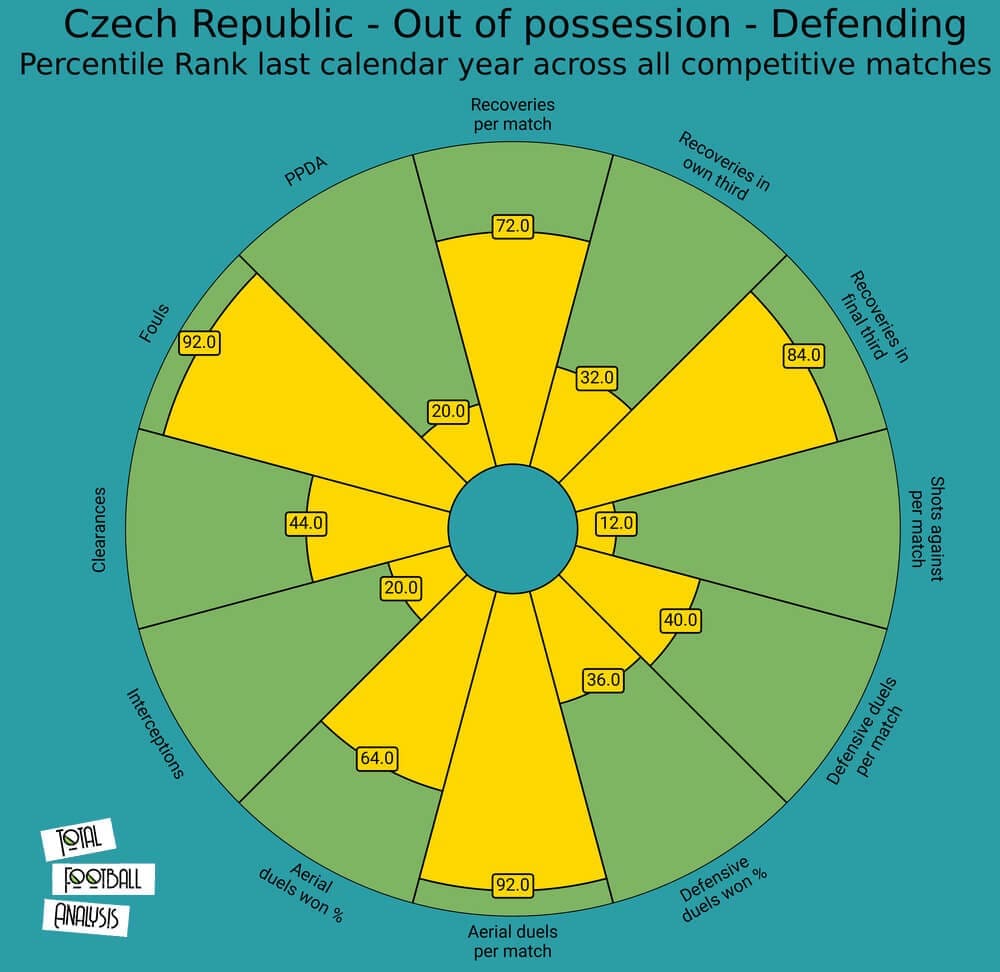
When we talk about the Czech Republic defending qualities we talk mostly about high intensity and aggression. The chart above will show us where the Czech Republic looks good when it comes to defending and what could be their weaknesses which opponents will try to exploit.
First, we will mention their PPDA (Passes allowed per defensive action) which in this case means the lower the percentile the higher the pressing. They are in the 20th percentile meaning they are one of the most intense teams in this tournament when it comes to pressing. To support that we can see that they are at the 84th percentile in recoveries in the final third showing that they are very good at pressing high and they are able to regain possession in the dangerous areas near the opponents’ goal. The reason for such quality numbers is that the whole team is very compatible in pressing attempts where we can often see eight players engaged in pressing actions deep in the opponents half. They are also one of the teams that make the most fouls and they are in the 92nd percentile in fouls per matches, below in the tactical part we will mention it in more detail.
Opposite to their recoveries in the final third, they are in the 32nd percentile when it comes to recoveries in their own third showing that they try to regain the possession away from goal more often than the other teams. They have a very low number of interceptions and a slightly below-average number of clearances per match.
Aerially they are looking very good, they have a lot of aerial duels and win 50% of their aerial duels which puts them in the top 10 teams in the tournament. It is no surprise given the fact that their team is very tall and from regular players, only Darida and Bořil are built smaller.
They are not looking good when it comes to defensive duels. They participate in fewer duels than an average team in a tournament and they sit at 36th percentile when it comes to defensive duels won%. These numbers can also be connected with a lot of fouls they make which is marked as a lost defensive duel. Whatever the reason, they will have to up their game in defensive duels if they want to be at the level needed to deliver quality results.
The last we will mention is their ability to prevent opponents from shooting on their goal. They allow 6.8 shots per match to their opponents and only England and Spain allow less which is impressive and tells a lot about their compactness in defence.
We’ll now take a look into a high press they often use in order to prevent opponents from progressing to their half with ground passes and making them make mistakes or hit long passes.
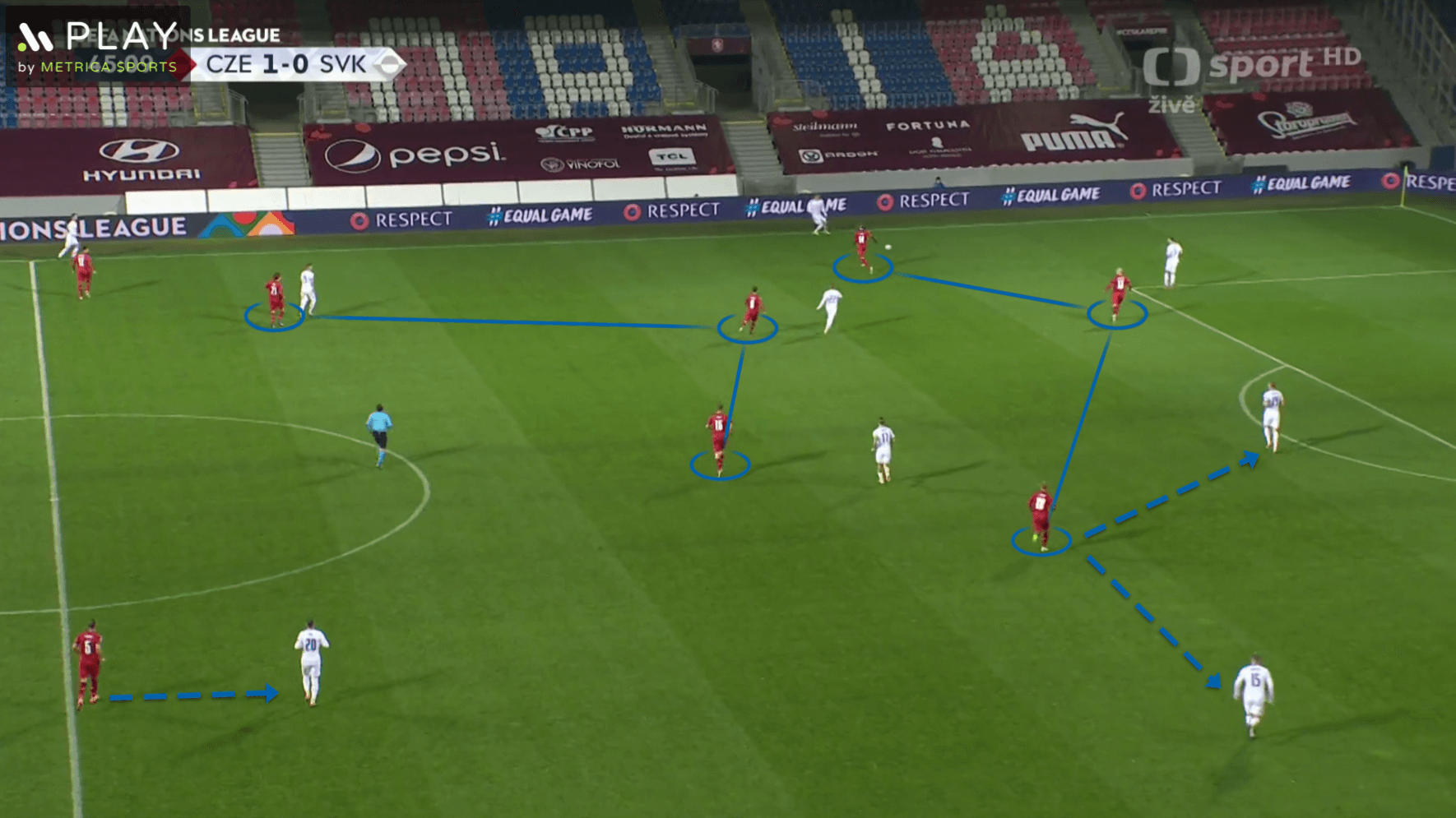
In the situation above we can see how the Czech Republic did high pressing on the Slovakian backline which attempted to build up the attack from deep. They like to wait for the opponent to pass towards the full-back before they increase their intensity in order to limit his time on the ball and to limit his options. We can see that the winger is pressing the full-back, the centre-forward is oriented on the closest centre-back while the opposite winger is close to the second centre-back but positioned just enough to be prepared to attack full-back on his side if the opponents switch flank.
The midfielders are tightly marking opponents midfielders while the full-backs are just above the half-line to be close to the opponent wingers. Intensity from both Bořil and Coufal is crucial in these situations and because they are capable of covering a lot of ground and putting instant pressure on wingers it makes the opponents harder to progress down the flanks.
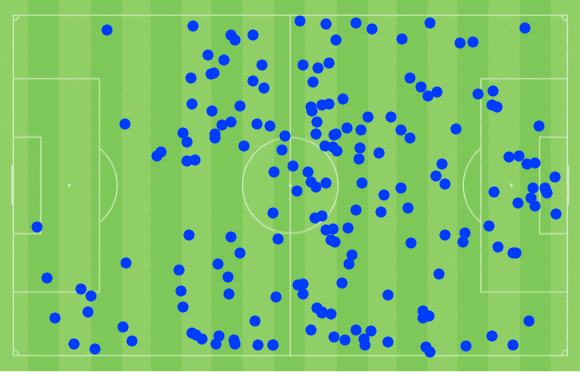
What the image above represents is the Czech Republic’s fouls in the last 10 matches. It is clear that they tend to make fouls in the opponents half. 118 of their 182 fouls were made in the opposition half which shows how intense and aggressive they are in the press. It also can indicate that when the opponent manages to avoid pressing or beat them in 1v1 situations they tend to make fouls to prevent them from progressing down the pitch.
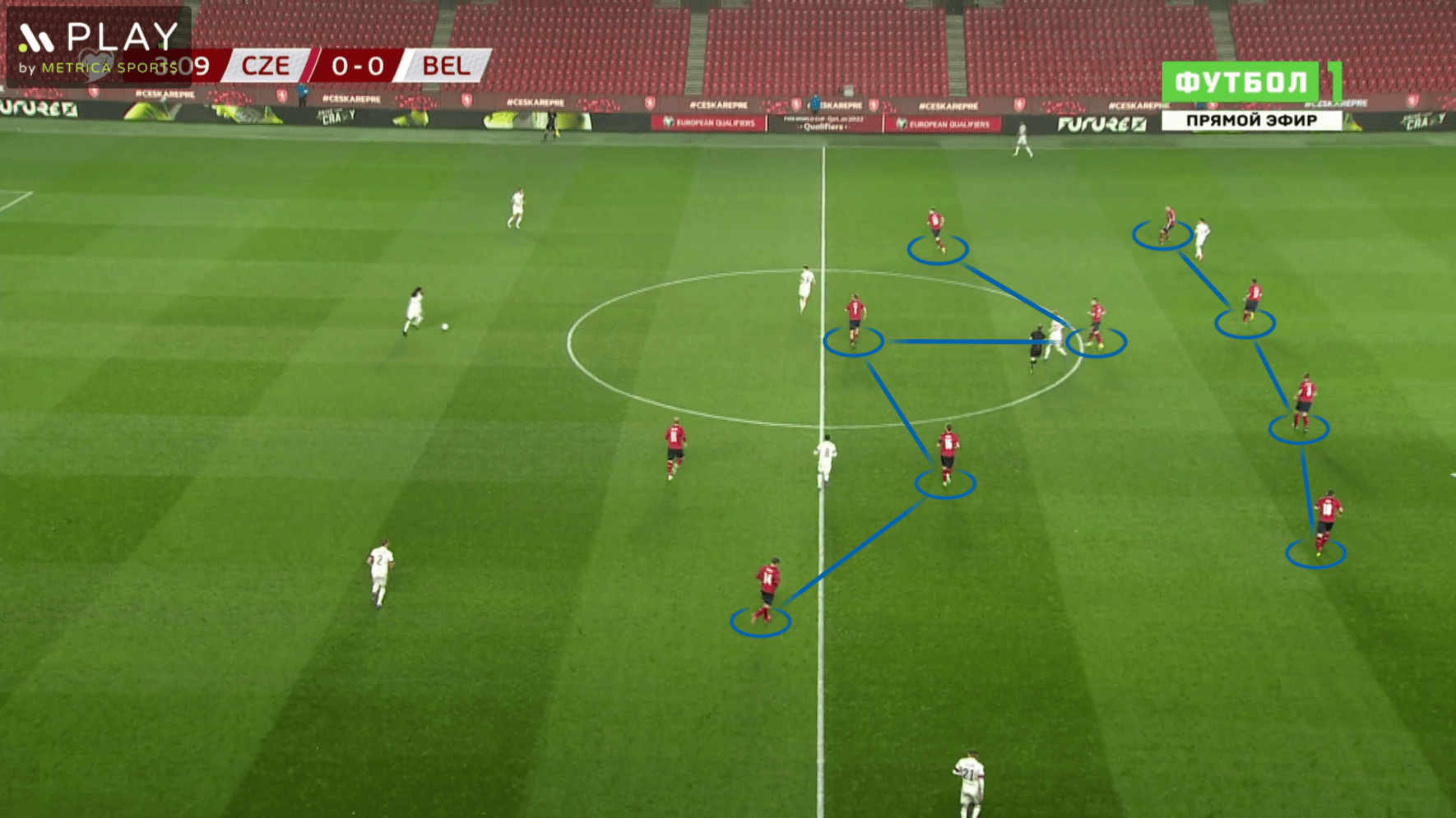
Given that the Czech Republic will face England and Croatia in the group stage they will have to be careful sometimes with their high pressing because both teams have quality centre-forwards who can hold on to the ball – Harry Kane and Bruno Petković. Through those two players, their opponents could bypass their high pressing and try to hurt them by running at their defence in wide space.
Because of that, we could see the Czech Republic take a careful approach and drop a little into a middle block which would then mean that they will pick the right situations to attempt high press. However, it is hard to predict what tactical approach Šilhavý will choose and it will depend a lot on their result in the first fixture against Scotland where they will surely look to press high and try to force them into mistakes.
TRANSITIONS
The segment where the Czech Republic thrives is the transition. When you have midfielders capable of covering a lot of space and full-backs who possess a high work rate and stamina it is easy to make it work in transitions which is exactly what the Czech Republic has at their disposal.
They look to attack from the moment they regain possession, especially if possession is regained in their own third and with a lot of space in front of them. The example below will show us how they look to exploit the opponent in a counter-attack.
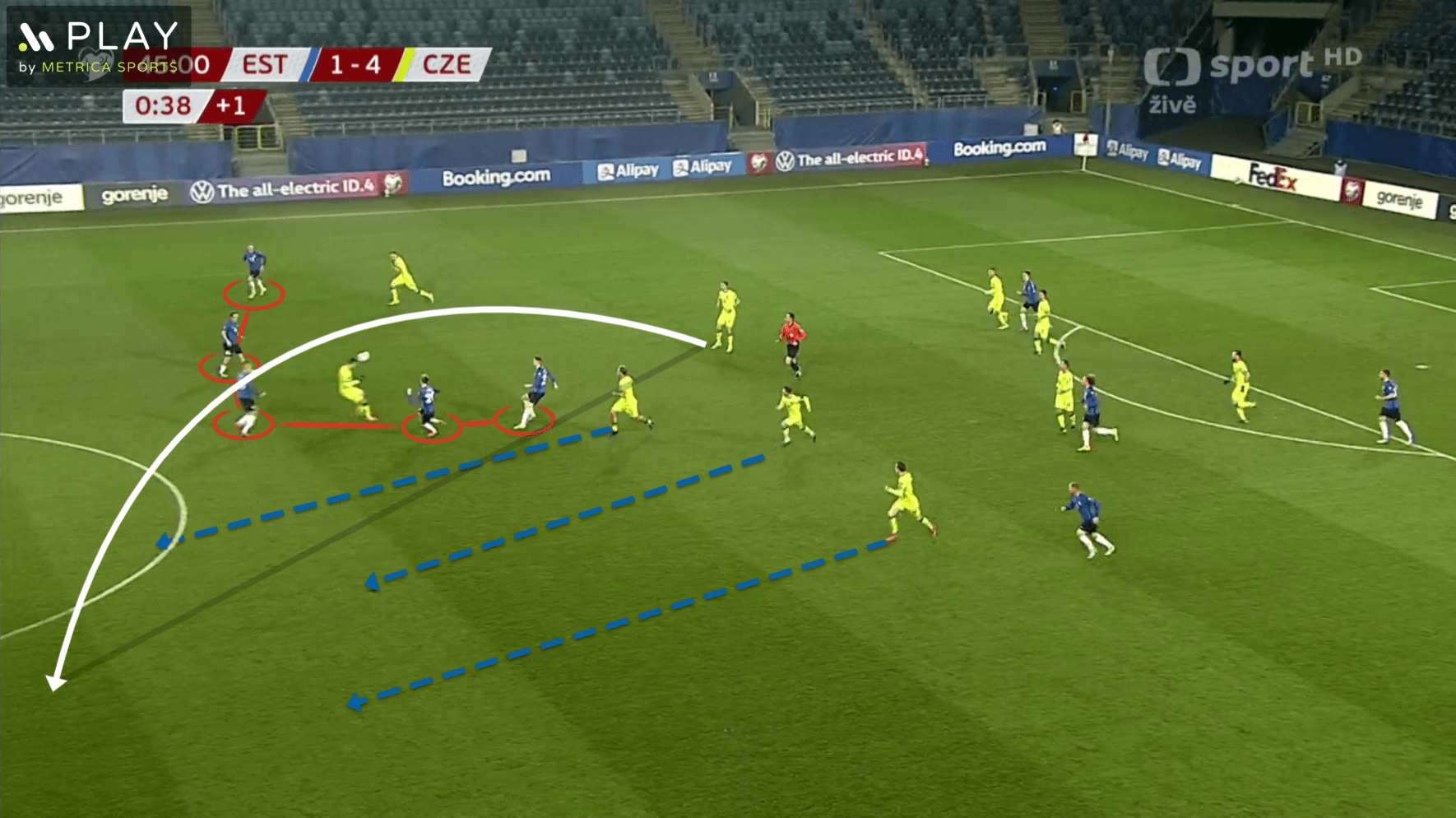
We can see in this situation how Schick is surrounded by few Estonian players which are oriented on the ball and not on the movement of the Czech Republic midfielders. Schick smartly looks to pass back towards Soucek who is unmarked. There are three players trying to exploit the left side of the pitch – Barák, Darida and Jankto. That means except for Soucek both midfielders are making a run forward and both wingers with Jankto having more space in front of him. Souček’s only task is to make an accurate pass into space over the five players surrounding Schick. Usually, they look for Darida to make that pass while Souček is running forward.
They will try to make the most out of this kind of situation and Jankto is the player they will target to carry the ball forward. Jankto’s mix of pace and creativity makes him the best carrier for counter-attacks. Both Barák and Souček are capable of supporting counter-attacks with their late arrivals into the box from where they can endanger the opponent’s goal.
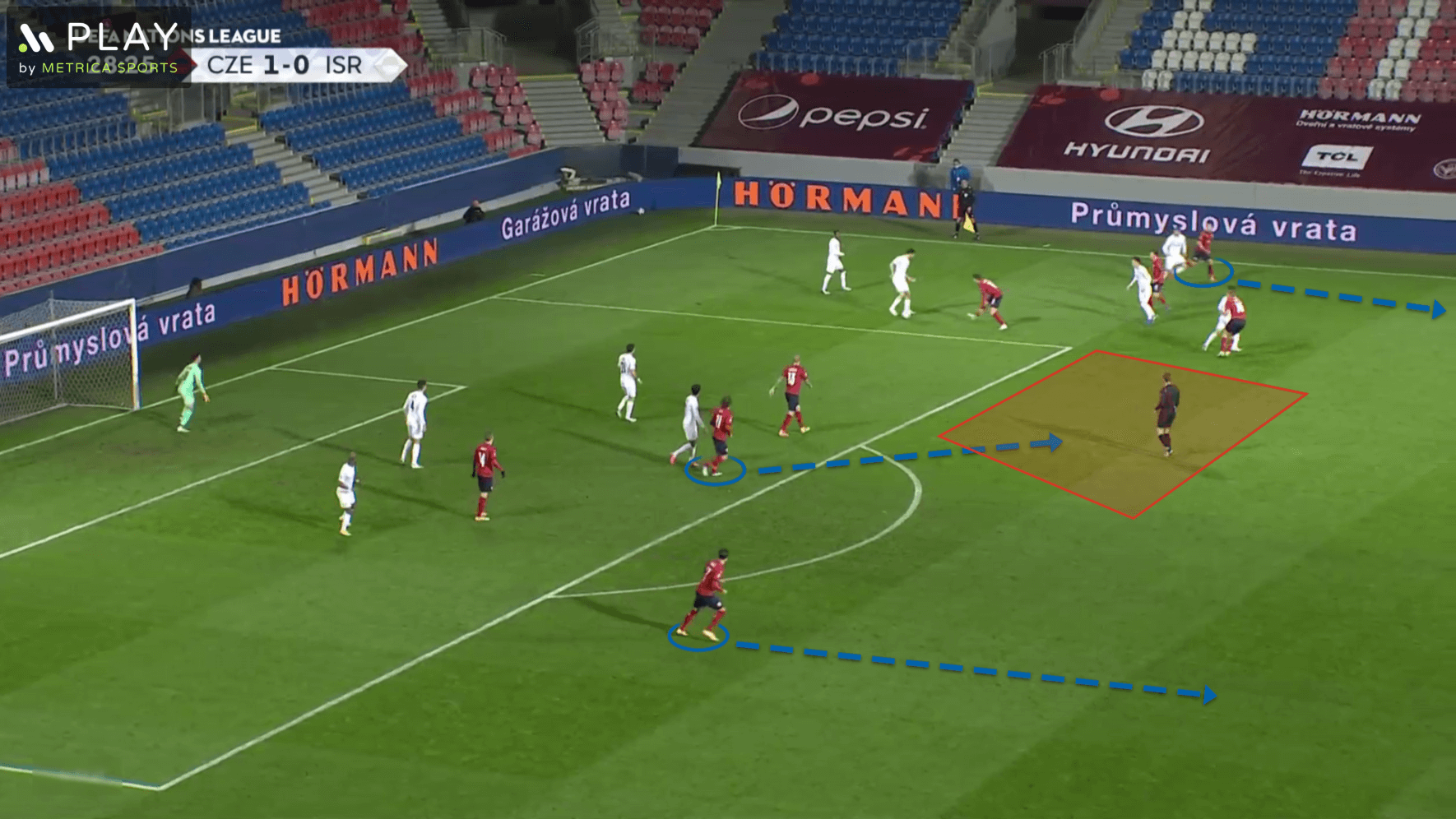
The Czech Republic looks very good in defensive transitions as well. They have a compact and high working group of players who don’t neglect defensive responsibilities. Everyone is capable of tracking back quickly and instantly structure a block to prevent the opponent from progressing closer to their goal.
In the example above we can see how they try to slow down the opponent from progressing down the pitch by attempting counter press when the ball is lost. The player who lost the ball instantly attacks the ball carrier, preventing him from passing quickly while the players around him are covering the nearest opponents. Both of their full-backs show instant reaction by tracking back to not leave centre-backs on wide space which is a very smart and proactive movement by them. The key part is Král moving into the red area where he acts as a corrector if the opponent manages to progress in the middle Král is there to stop the opponent from progressing further by dispossessing him or making a tactical foul.
These movements in defensive transitions are one of the reasons why they are so successful in recoveries in the final third and also why they are capable of stopping the opponent before progressing quickly down the pitch.
FORWARDS
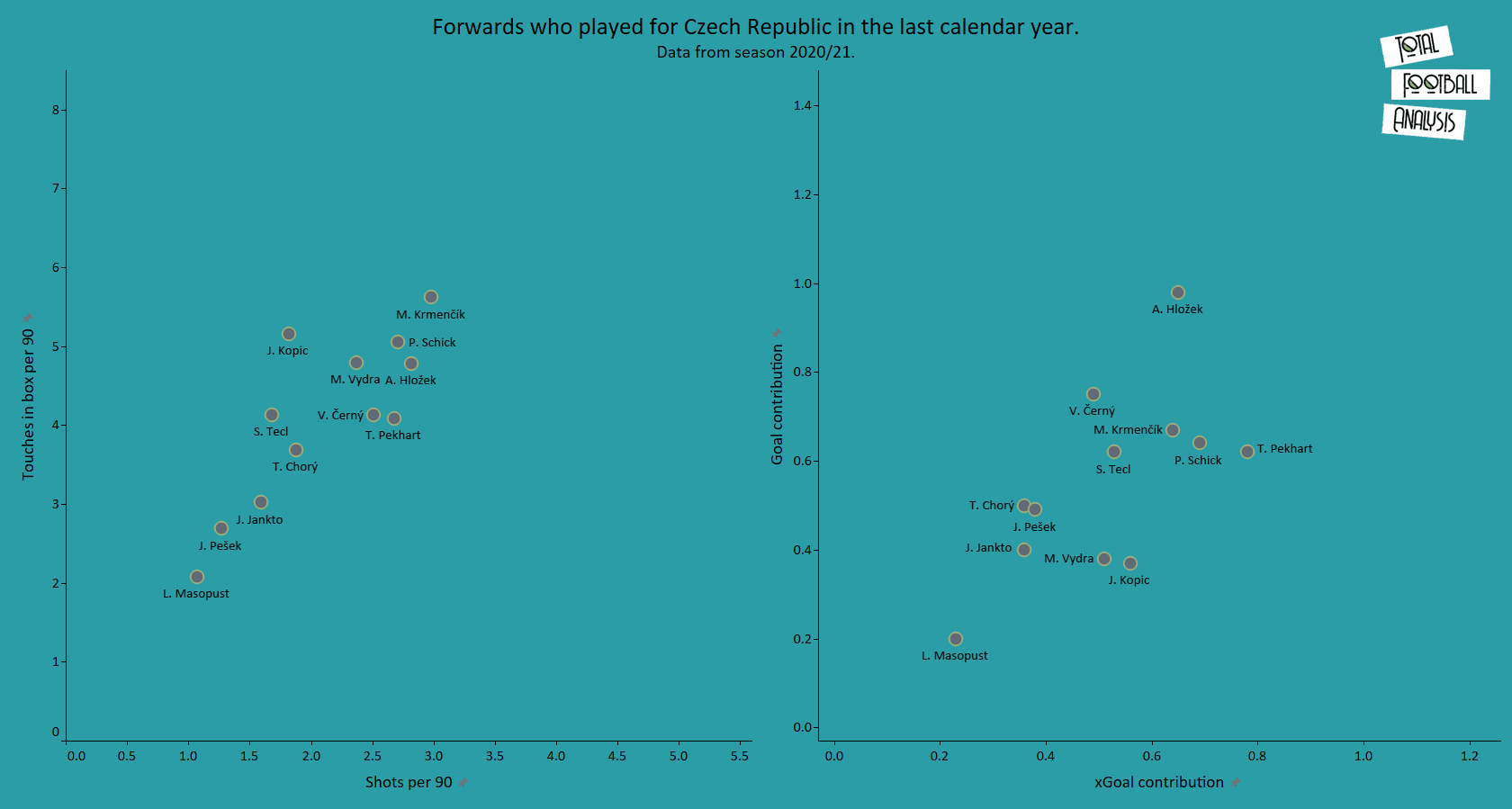
We’ll now take a look at all of the Czech Republic’s forwards who played for the team in the last calendar year. We will show their output in shots per 90 minutes and touches in the box on the left graph while on the right graph we will take a look into their xGoal contribution (expected goals + expected assists) and goal contribution (goals + assists).
Like we would expect, Krmenčík and Schick are the players who look good on both graphs. Krmenčík is the player with the most touches in the box and most shots amongst the forwards. Schick is very close to him, but we have to take into account that Schick plays in a better league where it is tougher to average those numbers.
Hot-prospect Adam Hložek looks great on both graphs and he is someone who could shine if given a chance. Many scouts will look at him if he gets minutes in the tournament because he was born in 2002 and already has 84 appearances for Sparta Prague. This season Hložek managed to score 11 goals and assist 8 times in 18 appearances in Fortuna Liga for Sparta Prague which is why he looks impressive on the goal contribution graph.
Masopust is looking the least dangerous player on both graphs and it is because he mostly plays as a right-back or right wing-back for Slavia Prague. However, in the Czech Republic, he gets used more on the wing since Coufal is irreplaceable on right-back. It is unfortunate that Černý injured his knee and won’t be available for the tournament since he is looking pretty good in both graphs.
MIDFIELDERS
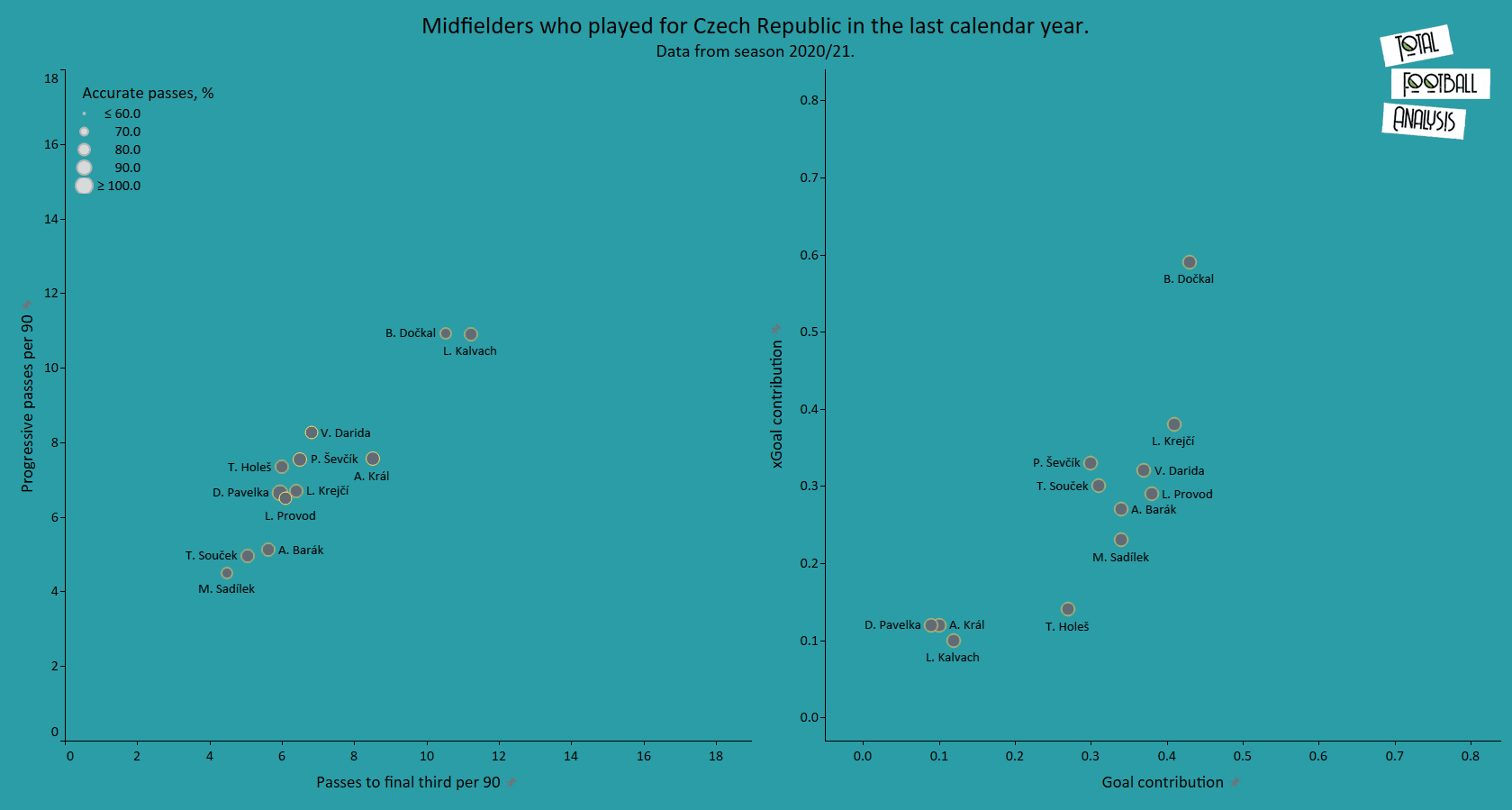
In this section, we will take a look into some interesting metrics for midfielders just like we did in the previous section for forwards. We decided to use the same graph on the right as in the previous section, while on the left graph we can see a number of attempted progressive passes and passes into the final third. The size of circles on the left graph represents the overall passing accuracy in %.
Vladimir Darida is showing quality numbers in both graphs as well, but in a tougher league where he plays for a team in the bottom half of the table. Darida is pulling strings in both Hertha Berlin and the Czech Republic and he is the main distributor of the ball. We can see that Souček is not the best distributor of the ball and he makes an impact with his smart off the ball movement.
Král is very close to Darida when it comes to ball distribution, however, he doesn’t contribute that much in the advanced areas of the pitch like Darida. Král can be labelled as a holding midfielder while Darida is also capable of playing as an attacking midfielder. Barák is also looking better in contribution graphs than in distribution since he is positioned higher on the pitch.
Ladislav Krejči looks good on both graphs given the fact that he plays as a defensive midfielder or centre-back. He would get his first call-up since he is one of the biggest talents they have currently, but unfortunately, he suffered a metatarsal fracture. The youngster would add quality depth for them in both positions he can play and he is a major aerial threat on set-pieces.
We can conclude that they have a very good balance in midfield and that Šilhavý has enough depth to mix things in the starting XI and adjust for the specific opponent.
DEFENDERS
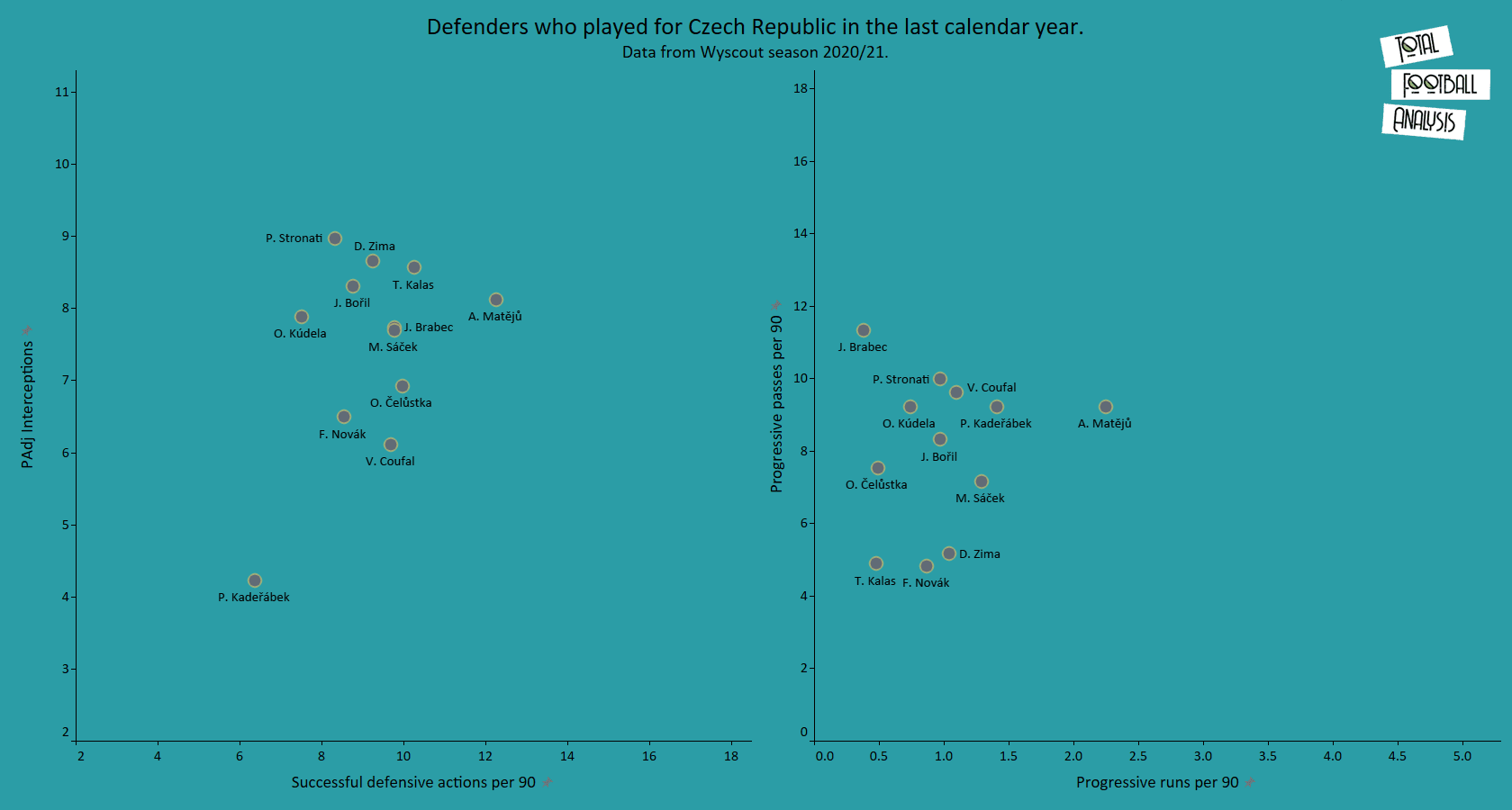
In this section, we will assess defenders based on their PAdj (possession-adjusted) interceptions and successful defensive actions per 90 on the left graph while on the right graph we will take a look into their progressive ability through progressive runs and progressive passes per 90.
When it comes to defensive metrics we can see that all the defenders show very good output in both defensive metrics on the graph. Only Pavel Kadeřábek is slightly worse than the rest of the defenders and it is because he plays as a wing-back in Bundesliga side Hoffenheim with more offensive duties. There is no player who stands out, but we have to mention David Zima and Jakub Brabec as two backups for Čelůstka and Kalas. Both of them show similar numbers to first-choice centre-backs meaning that Šilhavý is having sweet worries when it comes to choosing centre-backs. Brabec stands out in progressive passes per 90.
Brescia right-back Aleš Matějů stands out as a player with the most successful defensive actions, but also as the best progressive runner amongst the defenders. We can see that starting XI defenders Kúdela, Coufal and Bořil are all averaging more than 8 progressive passes per 90. However, when we take into account the Czech Republic style of play it is not very important to have defenders who can progress the ball through the build-up, because they rather look for direct long passes while Darida takes care of ball progression and often drops deeper to receive the ball before progressing it further.
BEST PERFORMER
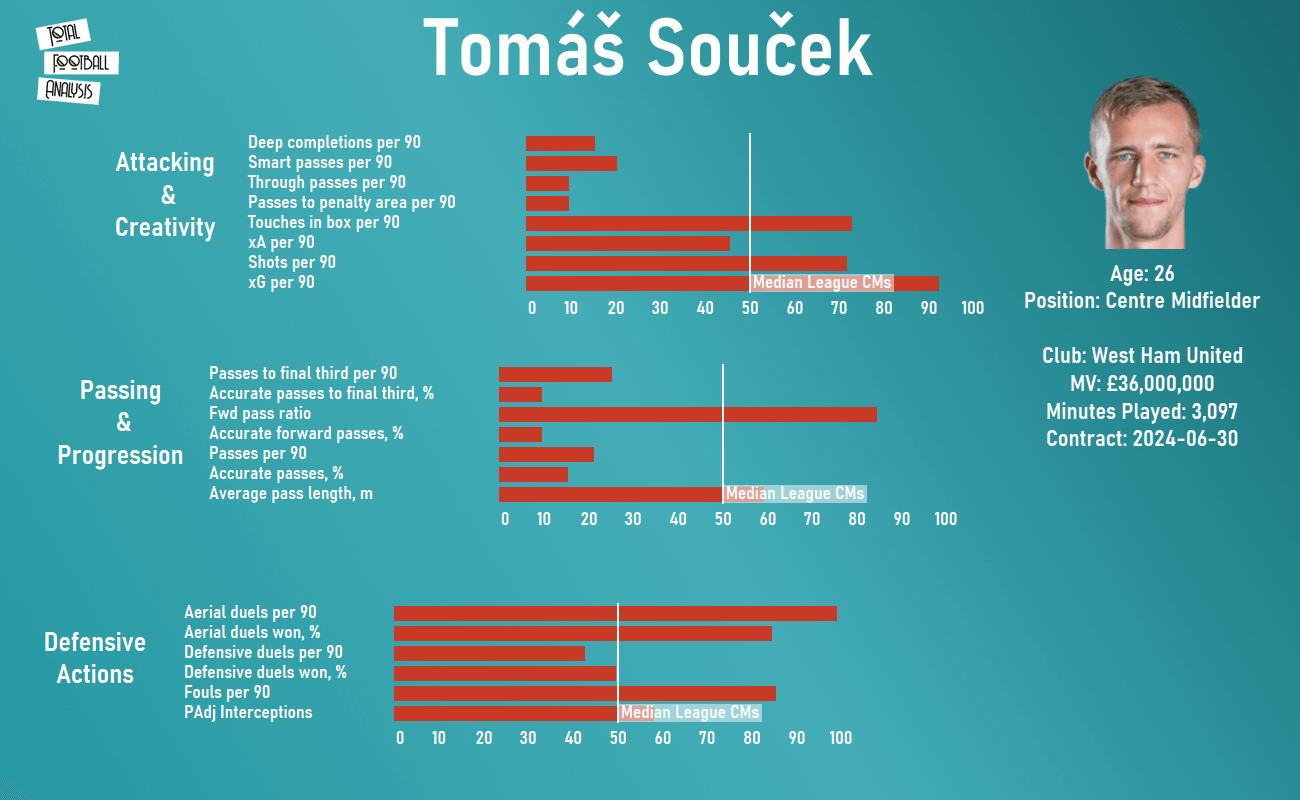
Tomaš Souček is a player whose stocks sky-rocketed in the last two years. At the time he arrived in West Ham his price on Transfermarkt was £10.8 million and now he is worth £36 million. He started all matches this season in the Premier League for West Ham and played all minutes. Souček managed to score 9 goals and assist once in the Premier League.
Based on the player profile above where he is compared to the midfielders from Premier League we will draw some conclusions. We can see in the first section that he isn’t a midfield creator and that he is a quality box-to-box player who knows how to get into promising situations. He is amongst the best in the league when it comes to xG per 90 and also he manages to average a lot of touches in the box and shots. His qualities are the perfect balance to Darida’s qualities, who is better when he is in the possession of the ball and facilitates for his teammates.
Just like the first section hinted he doesn’t make a big impact with his passing and neither has a lot of passes per 90. However, he tends to pass forward often and looks for longer distance passes which is a good complement to both West Ham and the Czech Republic playing style.
The last section on the visual above shows how valuable Souček is in the defensive phase. His height allows him to win a major part of his aerial duels and he has the highest number of aerial duels per 90 amongst the midfielders in the league. Aerial ability is also his strength in offensive set-pieces because of his good timing to attack crosses. He concedes a lot of fouls and it is valuable for his national team as well in order to prevent opponents’ progressing further especially when they break through their pressing.
Souček is clearly the star of this team and he became a star in such a short period because of his impressive performances in one of the best leagues in the world. It is now his time to lead the Czech Republic on the highest European stage when it comes to national team football.
PREDICTIONS FOR THE TOURNAMENT
Because of the new format, it is normal to expect the Czech Republic to go through the group stage. They are a better team than Scotland on paper, however, it will be a hard task because both Scotland and England will play on home turf which could be a slight advantage for them. The main problem is they lost the last three matches against Scotland and the last two matches were in 2020, if they lose again they will have to get a win against Croatia or England if they want to go through into the knockout phase.
In the Euro 2016 (the last big competition they participated in) they finished 4th in the group where they played against Spain, Croatia and Turkey. They lost two matches and drew with Croatia. That group was slightly tougher than the actual group because Croatia doesn’t look the same after the silver medal at the 2018 World Cup and the Turkey squad was the better team than the current Scotland squad. It is important to say that the Czech Republic has a better squad at their disposal than in the Euro 2016.
We can say that based on the quality of the squad and the recent performances they can go through to the next round. They have a very interesting playing style and few exciting players which will probably draw attention to their matches in this tournament.

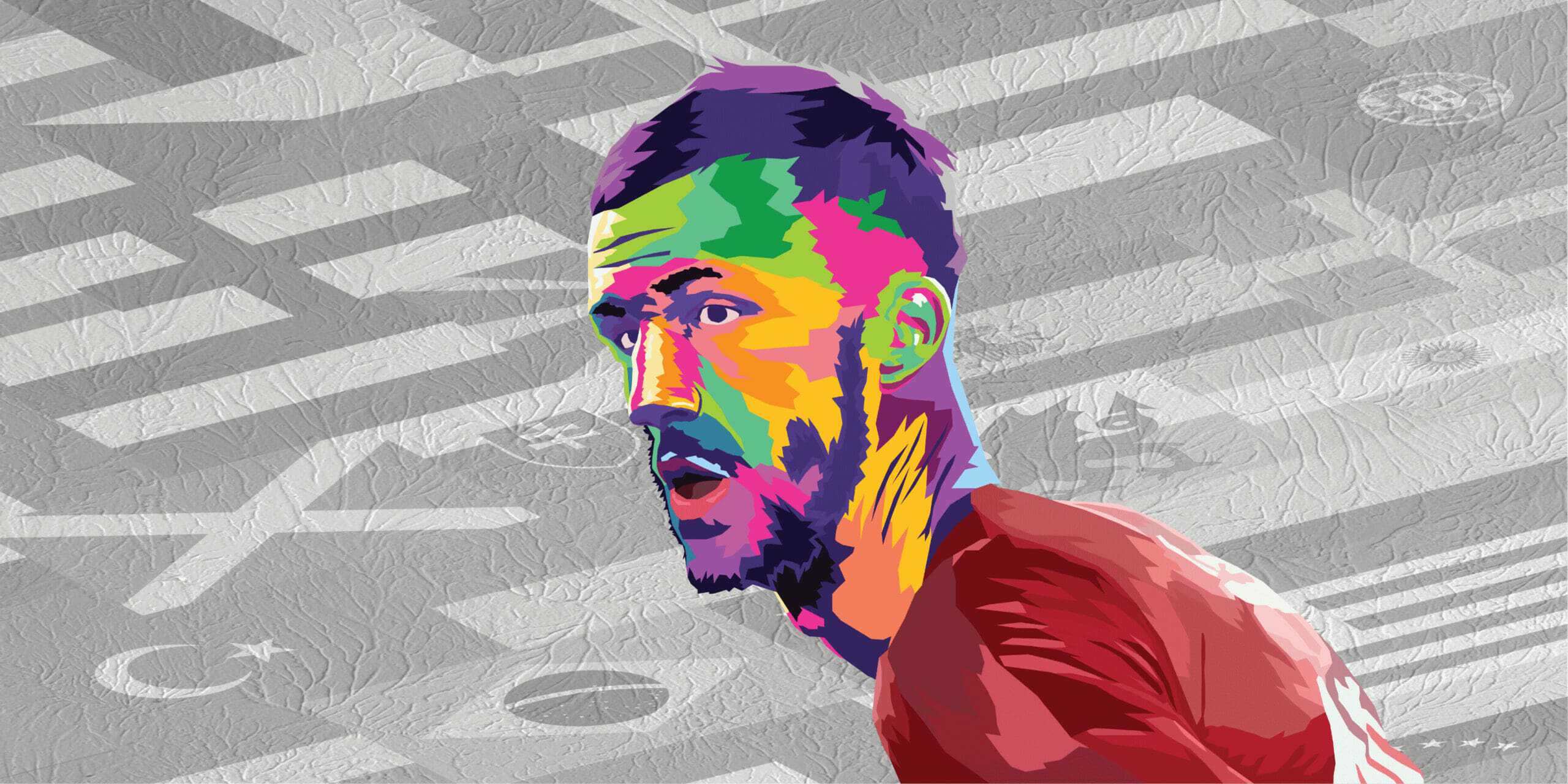



Comments